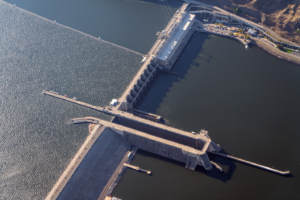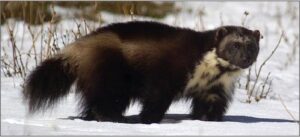I want to give you an overview of a few recent reports describing how climate is impacting birds, fish, and wolverines. Before I do, it’s worth zooming out just a little bit to remember how our energy system works.
Energy Islands
The western portion of North America (from New Mexico, to Montana and Alberta westward) share electricity through a system called the Western Interconnection. Much of the eastern US shares electricity among themselves, and Texas is its own energy-island that doesn’t share with anyone.
As we transition our grid to have more renewable energy, we need to be able to zip around electricity more efficiently across states. Remember that solar and wind energy have different times of day when they’re at peak production. Sometimes Arizona is exporting their solar generation capacity, and other times Washington is sending us their wind energy. At night, hydropower and gas plants and some battery storage keeps everything humming along. We share energy because the more we share the easier it is to balance supply with demand and to insulate us from regional storms that can knock out energy infrastructure (just ask Texas).
In the past, energy generation happened at fewer locations, and transmission lines were built as if they were small backcountry highways; just enough space for two cars to pass in either direction. But the energy systems we’re transitioning toward have many more energy generation facilities scattered everywhere; kinda like more onramps. But the more onramps, and greater energy demands, the more robust these ‘energy highways’ need to be. The transmission lines of yesteryear simply do not have the capacity we need in the 21st century. Hence the need for more transmission lines. Lots of them.

Birds and Power Lines
Enter the Audubon Society and their timely report around how transmission lines, and climate change, are impacting bird species. There’s no sugar coating these issues, the report notes “global warming could drive two-thirds of North American bird species to extinction.” Yes, it is true that electrocution can kill birds. But what’s also true is that for the last three years researchers examined bird deaths along ~200km of power lines in the western US; the leading cause of bird deaths were gunshots. The Audubon report underscores the reality that while we want to limit the negative impacts to birds from transmission lines, the impact of continuing on our current emissions trajectory is far, far worse. If the US is to reach net-zero emissions, we need to double or possibly triple our current transmission capacity. This Audubon report is just one example of how climate change is impacting wildlife that requires a re-evaluation of the status quo; these are uncomfortable realities for us in the conservation community where there are no right answers, only trade offs.

Dam Hot Water
Moving from the air to the water, I urge you to read Sammy Roth’s new investigative reporting piece around the removal of the four lower Snake River dams. I’ll summarize Roth’s incredible writing around energy issues in the West with this quote from our Executive Director, Justin Hayes: “Those dams are not clean energy if they are resulting in the extinction of species and cultures.” In this new world we have to remember not all dams are made alike, these four dams in question are especially good at capturing heat that regularly exceeds lethal temperatures for salmon. These four dams are not the only impediment to salmon recovery on the Columbia River drainage system, but breaching these dams give these salmon the best fighting chance to remain an integral part of the Pacific Northwest food web that has relied on them for centuries. What is that worth? Ask the Salmon People.

Following the Snow
Despite my high school having Wolverines as a mascot, I have not personally seen a wolverine (yet). The central and northern portions of Idaho are great habitat for wolverines, but they are highly dependent on deep spring snow. They also prefer to be relatively isolated from winter snowmobile recreation. A new report from U.S. Fish and Wildlife Service shows that although wolverine population numbers have been stable for a few decades, their low population numbers may not have enough genetic diversity to remain viable. Their dependance on snow for dens means they will soon need to adapt to climate change, which predicts ~50% less snow at elevations between 500-1,000m. Thankfully, higher elevation snowpacks (1,500-3,000m) in Idaho are predicted to be moderately influenced. If wolverines can get into higher areas, with tree cover, there’s still a chance for their populations to rebound. What happens if a wolverine den is at 900m, but their mountain tops out at 1,400m? These are the uncomfortable realities we must grapple with.
How do people fit in?
These are three examples from just the last few weeks of how climate, lands, and wildlife are interconnected but we’ve largely left out the people side of the equation. People built the dams, people are stopping renewable energy, and some people are adapting in any way they can. The energy system we built in the US is one of the most complicated machines ever devised. And if we built it before, we can rebuild it. In fact, we desperately need to do so quickly. This is a brave new world we’re embarking on, where we need to remain vigilant advocates for wild and outdoor spaces while acknowledging our outdoor spaces will inevitably change.
I will leave you the concluding remarks from Roth’s Snake River article that captures our conundrum rather well: “I’ve spent the week asking questions about Idaho. But the answers are relevant to the broader American West. We’re all part of the same electric grid, the same century-old machine with dozens of interlocking pieces that will either lift each other up or drag each other down as society moves on from fossil fuels. The more climate-friendly power on the Western grid, the easier it will be for all of us — red state or blue — to keep our air conditioners running without fossil fuels during the next heat wave.”
To sign up for ICL’s Climate Campaign updates, click here.
